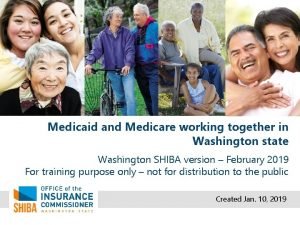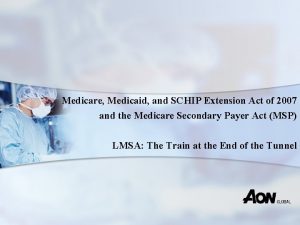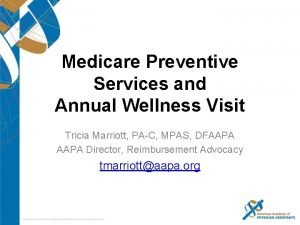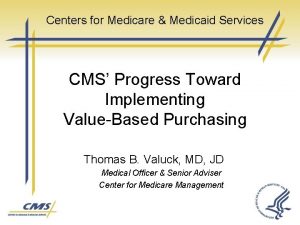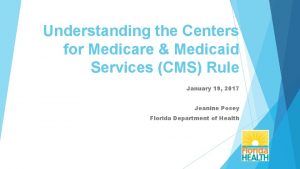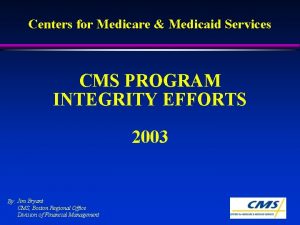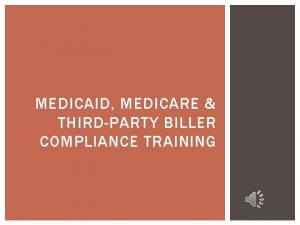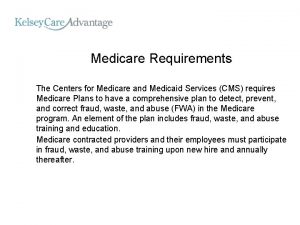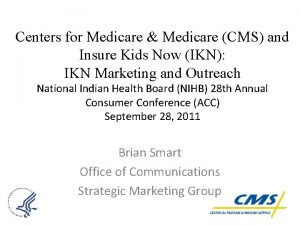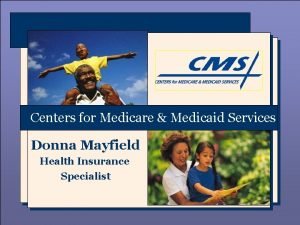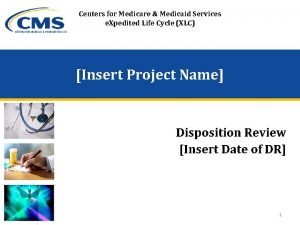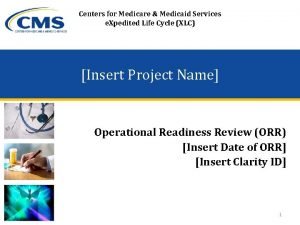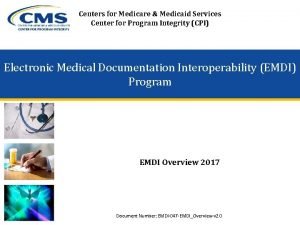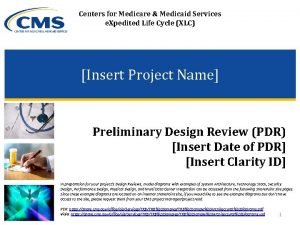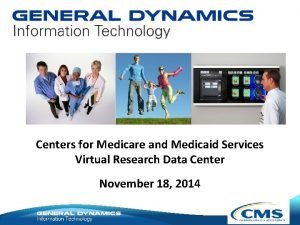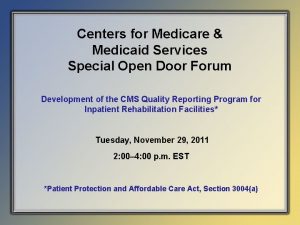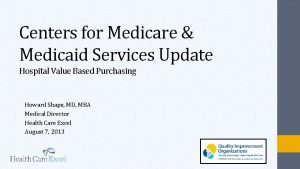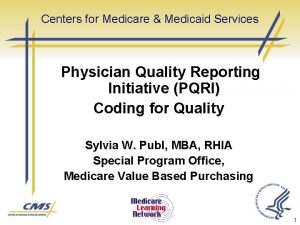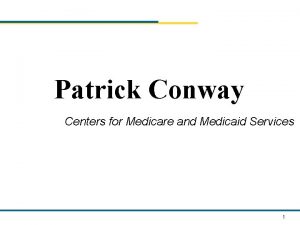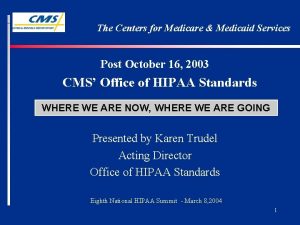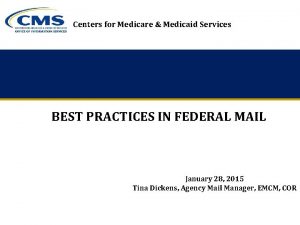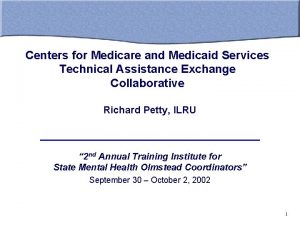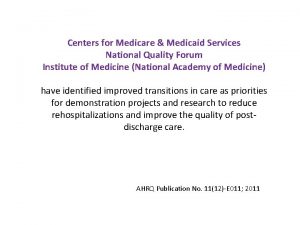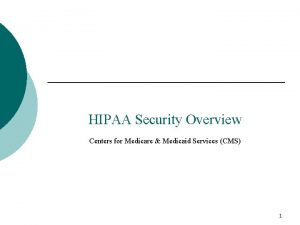Centers for Medicare Medicaid Services CMS Progress Toward











































































- Slides: 75

Centers for Medicare & Medicaid Services CMS’ Progress Toward Implementing Value-Based Purchasing Thomas B. Valuck, MD, JD Medical Officer & Senior Adviser Center for Medicare Management

Presentation Overview § CMS’ Value-Based Purchasing (VBP) Principles § CMS’ VBP Demonstrations and Pilots § CMS’ VBP Programs § Horizon Scanning and Opportunities for Participation

CMS’ Quality Improvement Roadmap § Vision: The right care for every person every time § Make care: § Safe § Effective § Efficient § Patient-centered § Timely § Equitable

CMS’ Quality Improvement Roadmap § Strategies § Work through partnerships § Measure quality and report comparative results § Value-Based Purchasing: improve quality and avoid unnecessary costs § Encourage adoption of effective health information technology § Promote innovation and the evidence base for effective use of technology

What Does VBP Mean to CMS? § Transforming Medicare from a passive payer to an active purchaser of higher quality, more efficient health care § Tools and initiatives for promoting better quality, while avoiding unnecessary costs § Tools: measurement, payment incentives, public reporting, conditions of participation, coverage policy, QIO program § Initiatives: pay for reporting, pay for performance, gainsharing, competitive bidding, bundled payment, coverage decisions, direct provider support

Why VBP? § Improve Quality § Quality improvement opportunity § Wennberg’s Dartmouth Atlas on variation in care § Mc. Glynn’s NEJM findings on lack of evidence-based care § IOM’s Crossing the Quality Chasm findings § Avoid Unnecessary Costs § Medicare’s various fee-for-service fee schedules and prospective payment systems are based on resource consumption and quantity of care, NOT quality or unnecessary costs avoided § Payment systems’ incentives are not aligned

Practice Variation

Practice Variation

Why VBP? § Medicare Solvency and Beneficiary Impact § Expenditures up from $219 billion in 2000 to a projected $486 billion in 2009 § Part A Trust Fund § Excess of expenditures over tax income in 2007 § Projected to be depleted by 2019 § Part B Trust Fund § Expenditures increasing 11% per year over the last 6 years § Medicare premiums, deductibles, and cost-sharing are projected to consume 28% of the average beneficiaries’ Social Security check in 2010

Workers per Medicare Beneficiary Worker to Beneficiary Ratio 4. 46 Source: OACT CMS and SSA 3. 39 2. 49

Percentage of GDP Under Current Law, Medicare Will Place An Unprecedented Strain on the Federal Budget Source: 2008 Trustees Report

Support for VBP § President’s Budget § FYs 2006 -09 § Congressional Interest in P 4 P and Other Value. Based Purchasing Tools § BIPA, MMA, DRA, TRCHA, MMSEA, MIPPA § Med. PAC Reports to Congress § P 4 P recommendations related to quality, efficiency, health information technology, and payment reform § IOM Reports § P 4 P recommendations in To Err Is Human and Crossing the Quality Chasm § Report, Rewarding Provider Performance: Aligning Incentives in Medicare § Private Sector § Private health plans § Employer coalitions

VBP Demonstrations and Pilots § Premier Hospital Quality Incentive Demonstration § Physician Group Practice Demonstration § Medicare Care Management Performance Demonstration § Nursing Home Value-Based Purchasing Demonstration § Home Health Pay for Performance Demonstration

VBP Demonstrations and Pilots § Medicare Health Support Pilots § Care Management for High-Cost Beneficiaries Demonstration § Medicare Healthcare Quality Demonstration § Gainsharing Demonstrations § Accountable Care Episode (ACE) Demonstration § Better Quality Information (BQI) Pilots § Electronic Health Records (EHR) Demonstration § Medical Home Demonstration

Premier Hospital Quality Incentive Demonstration

VBP Programs § Hospital Quality Initiative: Inpatient & Outpatient Pay for Reporting § Hospital VBP Plan & Report to Congress § Hospital-Acquired Conditions & Present on Admission Indicator Reporting § Physician Quality Reporting Initiative § Physician Resource Use Reporting § Home Health Care Pay for Reporting § ESRD Pay for Performance § Medicaid

VBP Programs Hospital Value-Based Purchasing

Hospital Quality Initiative § MMA Section 501(b) § Payment differential of 0. 4% for reporting (hospital pay for reporting) § FYs 2005 -07 § Starter set of 10 measures § High participation rate (>98%) for small incentive § Public reporting through CMS’ Hospital Compare website

Hospital Quality Initiative § DRA Section 5001(a) § Payment differential of 2% for reporting (hospital P 4 R) § FYs 2007 - “subsequent years” § Expanded measure set, based on IOM’s December 2005 Performance Measures Report § Expanded measures publicly reported through CMS’ Hospital Compare website § DRA Section 5001(b) § Report for hospital VBP beginning with FY 2009 § Report must consider: quality and cost measure development and refinement, data infrastructure, payment methodology, and public reporting

Hospital VBP Workgroup Tasks & Timeline 2006 Oct § Dec § 2007 Jan 17 § § Apr 12 § May § June § Nov 21 § Environmental Scan Issues Paper Listening Session #1 for Stakeholder Input on Issues Paper Options Paper Listening Session #2 for Input on Hospital VBP Options Paper Final Design Final Report, Including Design, Process, and Environmental Scan Report Submitted to Congress

Performance Model Overview § Hospitals submit data for all VBP measures that apply § CMS determines each hospital’s performance score on each measure: higher of 0 - 10 points on attainment or improvement § For each hospital, CMS aggregates scores across all measures within a domain (e. g. , clinical process-of-care measures, HCAHPS) § CMS weights and combines each hospital’s domain scores to determine the hospital’s Total Performance Score § CMS translates each hospital’s Total Performance Score into an incentive payment using an exchange function

Earning Clinical Process of Care Points: Example Measure: PN Pneumococcal Vaccination. 47 . 87 Benchmark Attainment Threshold Hospital I Attainment Range Score baseline • . 21. 70 performance • 1 • 2 • 3 • 4 • 5 • • 6 • 7 Attainment Range • 4 • 5 • 6 • 7 Improvement Range • 8 • • 8 9 • 9 Hospital I Earns: 6 points for attainment 7 points for improvement Hospital I Score: maximum of attainment or improvement = 7 points on this measure

Calculation of Total Performance Score § Each domain of measures is initially scored separately, weighting each measure within that domain equally § All domain scores are then combined, with the potential for different weighting by domain § Possible weighting to combine clinical process measures and HCAHPS: § 70% clinical process + 30% HCAHPS § As new domains are added (e. g. , outcomes), weights will be adjusted

Translating Performance Score into Incentive Payment: Example Hospital A Percent Of VBP Incentive Payment Earned Hospital Performance Score: % Of Points Earned Full Incentive Earned

VBP Plan Testing & Completion § Objectives: § Use most current RHQDAPU and Medicare hospital payment data to test VBP Performance Assessment Model § Complete methodology development § Small N § Topped-out measures § Exchange function equation § Examine financial impacts of VBP Incentive

Hospital VBP Report to Congress § The Hospital Value-Based Purchasing Report Congress can be downloaded from the CMS website at: http: //www. cms. hhs. gov/center/hospital. asp

VBP Initiatives Hospital-Acquired Conditions and Present on Admission Indicator Reporting

The HAC Problem § The IOM estimated in 1999 that as many as 98, 000 Americans die each year as a result of medical errors § Total national costs of these errors estimated at $17 -29 billion IOM: To Err is Human: Building a Safer Health System, November 1999. Available at: http: //www. iom. edu/Object. File/Master/4/117/To. Err-8 pager. pdf.

The HAC Problem § In 2000, CDC estimated that hospitalacquired infections add nearly $5 billion to U. S. health care costs annually Centers for Disease Control and Prevention: Press Release, March 2000. Available at: http: //www. cdc. gov/od/oc/media/pressrel/r 2 k 0306 b. htm. § A 2007 study found that, in 2002, 1. 7 million hospital-acquired infections were associated with 99, 000 deaths Klevens et al. Estimating Health Care-Associated Infections and Deaths in U. S. Hospitals, 2002. Public Health Reports. March-April 2007. Volume 122.

The HAC Problem § A 2007 Leapfrog Group survey of 1, 256 hospitals found that 87% of those hospitals do not consistently follow recommendations to prevent many of the most common hospital-acquired infections 2007 Leapfrog Group Hospital Survey. The Leapfrog Group 2007. Available at: http: //www. leapfroggroup. org/media/file/Leapfrog_hospital_acquired_ infections_release. pdf

Statutory Authority: DRA Section 5001(c) § Beginning October 1, 2007, IPPS hospitals were required to submit data on their claims for payment indicating whether diagnoses were present on admission (POA) § Beginning October 1, 2008, CMS cannot assign a case to a higher DRG based on the occurrence of one of the selected conditions, if that condition was acquired during the hospitalization

Statutory Selection Criteria § CMS must select conditions that are: 1. High cost, high volume, or both 2. Assigned to a higher paying DRG when present as a secondary diagnosis 3. Reasonably preventable through the application of evidence-based guidelines

HAC Selection Process § The CMS and Centers for Disease Control and Prevention (CDC) internal Workgroup selected the HACs § Informal comments from stakeholders § CMS/CDC sponsored Listening Session § December 17, 2007 § Ad hoc meetings with stakeholders § Inpatient Prospective Payment System (IPPS) rulemaking § Proposed and Final rules for Fiscal Years (FY) 2007, 2008, 2009

Selected HACs for Implementation 1. 2. 3. 4. Foreign object retained after surgery Air embolism Blood incompatibility Pressure ulcers § Stages III & IV 5. Falls § § § Fracture Dislocation Intracranial injury Crushing injury Burn Electric shock

Selected HACs for Implementation 6. Manifestations of poor glycemic control § § § Hypoglycemic coma Diabetic ketoacidosis Nonkeototic hyperosmolar coma Secondary diabetes with ketoacidosis Secondary diabetes with hyperosmolarity 7. Catheter-associated urinary tract infection 8. Vascular catheter-associated infection 9. Deep vein thrombosis (DVT)/pulmonary embolism (PE) § § Total knee replacement Hip replacement

Selected HACs for Implementation 10. Surgical site infection § Mediastinitis after coronary artery bypass graft (CABG) § Certain orthopedic procedures § § Spine Neck Shoulder Elbow § Bariatric surgery for obesity § Laprascopic gastric bypass § Gastroenterostomy § Laparoscopic gastric restrictive surgery

Infectious Agents § Directly addressed by selecting infections as HACs § Example: MRSA § Coding § To be selected as an HAC, the conditions must be a CC or MCC § Considerations § Community-acquired v. hospital-acquired § Colonization v. infection

Relationship Between CMS' HACs and NQF’s “Never Events” 1. 2. 3. 4. 5. 6. 7. 8. Foreign object retained after surgery Air embolism Blood incompatibility Pressure ulcers Falls Burns Electric Shock Hypoglycemic Coma

CMS’ Authority to Address the NQF’s “Never Events” § CMS applies its authorities in various ways, beyond the HAC payment provision, to combat “never events: ” § § Conditions of participation for survey and certification Quality Improvement Organization (QIO) retrospective review Medicaid partnerships Coverage policy

CMS’ Authority to Address the NQF’s “Never Events” § National Coverage Determinations (NCDs) § CMS is evaluating evidence regarding three surgical “never events: ” § § Surgery performed on the wrong body part Surgery performed on the wrong patient Wrong surgery performed on a patient NCD tracking sheets are available at: http: //www. cms. hhs. gov/mcd/index_list. asp? list_type=nca

CMS’ Authority to Address the NQF’s “Never Events” § State Medicaid Director Letter (SMD) § § Advises States about how to coordinate State Medicaid Agency policy with Medicare HAC policy to preclude Medicaid payment for HACs when Medicare does not pay http: //www. cms. hhs. gov/SMDL/downloads/SMD 07 3108. pdf

Present on Admission Indicator (POA) CMS’ Implementation of POA Indicator Reporting

POA Indicator General Requirements § Present on admission (POA) is defined as present at the time the order for inpatient admission occurs § § Conditions that develop during an outpatient encounter, including emergency department, observation, or outpatient surgery, are considered POA indicator is assigned to § § § Principal diagnosis Secondary diagnoses External cause of injury codes (Medicare requires reporting only if E-code is reported as an additional diagnosis)

POA Indicator Reporting Options POA Indicator Options and Definitions Code Reason for Code Y Diagnosis was present at time of inpatient admission. N Diagnosis was not present at time of impatient admission. U Documentation insufficient to determine if condition was present at the time of inpatient admission. W Clinically undetermined. Provider unable to clinically determine whether the condition was present at the time of inpatient admission. 1 Unreported/Not used. Exempt from POA reporting. This code is equivalent code of a blank on the UB-04; however, it was determined that blanks are undesirable when submitting this data via the 4010 A.

POA Indicator Reporting Options § POA indicator § CMS pays the CC/MCC for HACs that are coded as “Y” & “W” § CMS does NOT pay the CC/MCC for HACs that are coded “N” & “U”

POA Indicator Reporting Requires Accurate Documentation “ A joint effort between the healthcare provider and the coder is essential to achieve complete and accurate documentation, code assignment, and reporting of diagnoses and procedures. ” ICD-9 -CM Official Guidelines for Coding and Reporting

HAC & POA Enhancement & Future Issues § Future Enhancements to HAC payment provision § Risk adjustment § Individual and population level § Rates of HACs for VBP § Appropriate for some HACs § Uses of POA information § Public reporting § Adoption of ICD-10 § Example: 125 codes capturing size, depth, and location of pressure ulcer § Expansion of the IPPS HAC payment provision to other settings § Discussion in the IRF, OPPS/ASC, SNF, LTCH regulations

Opportunities for HAC & POA Involvement § Updates to the CMS HAC & POA website: www. cms. hhs. gov/Hospital. Acq. Cond/ § FY 2010 Rulemaking § Hospital Open Door Forums § Hospital Listserv Messages

VBP Programs Physician Quality Reporting Initiative (PQRI)

Quality and PQRI § PQRI has focused attention on measuring quality of care § Foundation is evidence-based measures developed by professionals § Reporting data for quality measurement is rewarded with financial incentive § Measurement enables improvements in care § Reporting is the first step toward pay for performance

PQRI 2007 § Tax Relief and Health Care Act of 2006 (TRHCA) § Authorized establishment of a physician quality reporting system § Included 1. 5% incentive payment for satisfactorily reporting quality data on covered professional services furnished to Medicare beneficiaries July 1—December 31, 2007

PQRI 2007 § 2007 Participation Data § About 16% or 100, 000 professionals participated by submitting at least one quality-data code § Over half of participants or about 57, 000 met the statutory requirement to qualify for the incentive payment § 2007 PQRI Payments have been made and feedback reports are available

PQRI 2008 § Published in 2008 Medicare Physician Fee Schedule (PFS) Final Rule November 2007 § 119 measures § 117 clinical measures § 2 structural measures § Clinical measures apply to specialties accounting for over 95% of Medicare Part B spending § Structural measures apply broadly across specialties and disciplines

PQRI 2008 § Medicare, Medicaid, and SCHIP Extension Act of 2007 (MMSEA) authorized 2008 continuation of PQRI § Eliminated cap on incentive payment § Incentive payment remains 1. 5% of total allowable charges for Medicare PFS covered professional services furnished during reporting period § Required alternative reporting periods and alternative reporting criteria for 2008 and 2009

PQRI 2008 § TRHCA authorized one approach for reporting § MMSEA required establishment of alternative reporting periods/reporting criteria for measures groups and registry based reporting § 8 new options established effective April 15, 2008: See 2008 PQRI: Establishment of Alternative Reporting Periods and Reporting Criteria document posted at: www. cms. hhs. gov/PQRI

PQRI 2008 Incentive Payments § Must satisfactorily report under at least one method to qualify for 1. 5% incentive § CMS will review data submitted via all methods to determine satisfactory reporting and eligibility § Maximum incentive payment is 1. 5% of total allowed PFS charges for Part B covered services for the applicable reporting period § If qualify for more than one 2008 PQRI reporting method, then will receive incentive for longest reporting period

PQRI 2008 Goals § Expand Participation § Expand measures for 2009 § Implement alternative criteria for measure groups and registry-based reporting § Implement alternative reporting periods § Prepare to accept EHR-reported measures for 2009

PQRI & e-prescribing MIPPA Provisions § Section 131: PQRI for 2009 and Beyond § Incentive increased to 2% § Audiologists added as qualified professionals § Section 132: e-prescribing incentives § Incentive 2% for 2009 -10, then 1% for 2011 -12, then 0. 5% for 2013 § Penalty of 1% begins in 2012, then 1. 5% for 2013, then 2% for 2014 § Hardship exception § Follow Physician Fee Schedule Rulemaking for more on 2009 PQRI and e-prescribing

Additional PQRI Resources For more PQRI information you may contact your Regional Office, Carrier/MAC, or visit http: //www. cms. hhs. gov/PQRI

VBP Initiatives Physician Resource Use

Efficiency in the Quality Context § Efficiency Is One of the Institute of Medicine's Key Dimensions of Quality 1. 2. 3. 4. 5. Safety Effectiveness Patient-Centeredness Timeliness Efficiency: absence of waste, overuse, misuse, and errors 6. Equity • Institute of Medicine: Crossing the Quality Chasm: A New Health System for the 21 st Century, March, 2001.

Resource Use Measurement § Goals § Measures that are meaningful, actionable, and fair § Compare expected to actual resource use § Link resource use to measures of quality and patient experiences of care

Measurement Challenges § Grouping claims into episodes of care meaningfulness § Attribution - assigning responsibility § Benchmarks - making comparisons § Risk adjustment - fairness § Small numbers - reliability § Feedback reports - actionability

Episode of Care § What is it? § All clinical interactions with the patient regarding a specific health problem during a specified period of time § Why do it? § More meaningful for a physician to be responsible for an episode than to be held responsible for all care a patient receives § How is it measured? § Commercial episode grouper software; future alternatives possible

What is an Episode Grouper? § Software that organizes claims data into clinically coherent episodes § Captures all clinical interactions with the patient regarding a specific health problem during a specified period of time § Creates clinically homogeneous episodes § Uses proprietary logic

Episode Timeline Episode Duration Lookback Episode period initiating. . . Some events are not part of this episode event Clean Period. . . Episode Visit or procedure Ancillary services--i. e. , lab, radiology, etc.

Commercial Grouper Software Medical Episode Groups (MEGs) Episode Treatment Groups (ETGs) § Thomson-Reuters (Medstat) § United Health. Care (Ingenix/Symmetry) § Released in 1998, periodically updated § Released in early 1990 s, periodically updated § 570 episode groups (MEGs) § Based primarily on Dx codes § 465 base episode groups (ETGs) § Based on Dx and procedure codes

Episode Grouper Evaluation § Grouper functionality § Grouper clinical logic § Phased pilot dissemination of physician resource use reports § Alternatives to groupers

Creating Resource Use Reports 1 Prepare claims data 2 Group claims into episodes 3 Risk-adjust the cost of each episode 4 Attribute each episode to one or more physicians 5 Calculate physician’s efficiency score 6 Compare score to a benchmark 7 Produce and distribute RURs

Physician Resource Use Reports § Phased Pilot Approach § Phase I tasks (April 2008 -March 2009) § Use both ETG and MEG episode groupers § Standardize unit prices § Assess several approaches to: § Risk adjustment § Attribution § Benchmarking § Produce RURs for several acute and chronic conditions § Conduct in-depth interviews with physicians § Pilot test with a large sample of providers

Physician Resource Use Reports Pilot § Potential Next Phase § Explore combining efficiency measures with quality measures § Continue to improve the validity, usability, and fairness of RURs § Scale-up if warranted

Physician Resource Use Reports Pilot § Statutory Authority § Medicare Improvement for Patients and Providers Act of 2008, Section 131(c) § The Secretary shall establish a Physician Feedback Program under which the Secretary shall use claims data (and may use other data) to provide confidential reports to physicians (and, as determined appropriate by the Secretary, to groups of physicians) that measure the resources involved in furnishing care. The Secretary may include information on the quality of care furnished by the physician (or group of physicians) in such reports.

Horizon Scanning and Opportunities for Participation § IOM Payment Incentives Report § Three-part series: Pathways to Quality Health Care § Med. PAC § Ongoing studies and recommendations regarding VBP § Congress § VBP legislation this session? § CMS Proposed Regulations § Seeking public comment on the VBP building blocks § CMS Demonstrations and Pilots § Periodic evaluations and opportunities to participate

Horizon Scanning and Opportunities for Participation § CMS Implementation of MMA, DRA, TRHCA, MMSEA, and MIPPA VBP provisions § Demonstrations, P 4 R programs, VBP planning § Measure Development § Foundation of VBP § Value-Driven Health Care Initiative § Expanding nationwide § Quality Alliances and Quality Alliance Steering Committee § AQA Alliance and HQA adoption of measure sets and oversight of transparency initiative

Thank You Thomas B. Valuck, MD, JD Medical Officer & Senior Adviser Center for Medicare Management Centers for Medicare & Medicaid Services
 Shiba rainbow chart
Shiba rainbow chart Yom kippur war apush
Yom kippur war apush Medicare set aside flow chart
Medicare set aside flow chart Speech to the young
Speech to the young Speech to the young speech to the progress-toward theme
Speech to the young speech to the progress-toward theme Physical progress and financial progress
Physical progress and financial progress Medicare preventive services quick reference
Medicare preventive services quick reference Borstål, egenskaper
Borstål, egenskaper Orubbliga rättigheter
Orubbliga rättigheter Underlag för särskild löneskatt på pensionskostnader
Underlag för särskild löneskatt på pensionskostnader Verktyg för automatisering av utbetalningar
Verktyg för automatisering av utbetalningar Texter för hinduer tantra
Texter för hinduer tantra Bamse för de yngsta
Bamse för de yngsta Vad är hsil
Vad är hsil I gullregnens månad
I gullregnens månad Strategi för svensk viltförvaltning
Strategi för svensk viltförvaltning Boverket ka
Boverket ka Informationskartläggning
Informationskartläggning Tack för att ni har lyssnat
Tack för att ni har lyssnat Läkarutlåtande för livränta
Läkarutlåtande för livränta Klassificeringsstruktur för kommunala verksamheter
Klassificeringsstruktur för kommunala verksamheter Vad står k.r.å.k.a.n för
Vad står k.r.å.k.a.n för Cks
Cks Inköpsprocessen steg för steg
Inköpsprocessen steg för steg Påbyggnader för flakfordon
Påbyggnader för flakfordon Sura för anatom
Sura för anatom Egg för emanuel
Egg för emanuel Atmosfr
Atmosfr R formel
R formel Vilotidsbok
Vilotidsbok Rutin för avvikelsehantering
Rutin för avvikelsehantering Biologiska arvet
Biologiska arvet Formuö
Formuö Myndigheten för delaktighet
Myndigheten för delaktighet Presentera för publik crossboss
Presentera för publik crossboss Mall för debattartikel
Mall för debattartikel Kung som dog 1611
Kung som dog 1611 Tack för att ni lyssnade
Tack för att ni lyssnade Tobinskatten för och nackdelar
Tobinskatten för och nackdelar Vad är referatmarkeringar
Vad är referatmarkeringar Karttecken höjdkurva
Karttecken höjdkurva Varför kallas perioden 1918-1939 för mellankrigstiden?
Varför kallas perioden 1918-1939 för mellankrigstiden? Programskede byggprocessen
Programskede byggprocessen Rådet för byggkompetens
Rådet för byggkompetens Formel för lufttryck
Formel för lufttryck Vad är densitet
Vad är densitet Elektronik för barn
Elektronik för barn Borra hål för knoppar
Borra hål för knoppar Tack för att ni har lyssnat
Tack för att ni har lyssnat Smärtskolan kunskap för livet
Smärtskolan kunskap för livet Jiddisch
Jiddisch Typiska drag för en novell
Typiska drag för en novell Luftstrupen för medicinare
Luftstrupen för medicinare Frgar
Frgar Delegerande ledarskap
Delegerande ledarskap Humanitr
Humanitr Uppställning multiplikation
Uppställning multiplikation Toppslätskivling dos
Toppslätskivling dos Redogör för vad psykologi är
Redogör för vad psykologi är Mat för unga idrottare
Mat för unga idrottare Skapa med geometriska former
Skapa med geometriska former Bris för vuxna
Bris för vuxna En lathund för arbete med kontinuitetshantering
En lathund för arbete med kontinuitetshantering Ledarskapsteorier
Ledarskapsteorier Publik sektor
Publik sektor Antikt plagg i rom
Antikt plagg i rom Datorkunskap för nybörjare
Datorkunskap för nybörjare Rita perspektiv
Rita perspektiv Ministerstyre för och nackdelar
Ministerstyre för och nackdelar Vem räknas som jude
Vem räknas som jude Nationell inriktning för artificiell intelligens
Nationell inriktning för artificiell intelligens Bästa kameran för astrofoto
Bästa kameran för astrofoto Tillitsbaserad ledning
Tillitsbaserad ledning Nyckelkompetenser för livslångt lärande
Nyckelkompetenser för livslångt lärande Romarriket tidslinje
Romarriket tidslinje Dikt med rim
Dikt med rim
